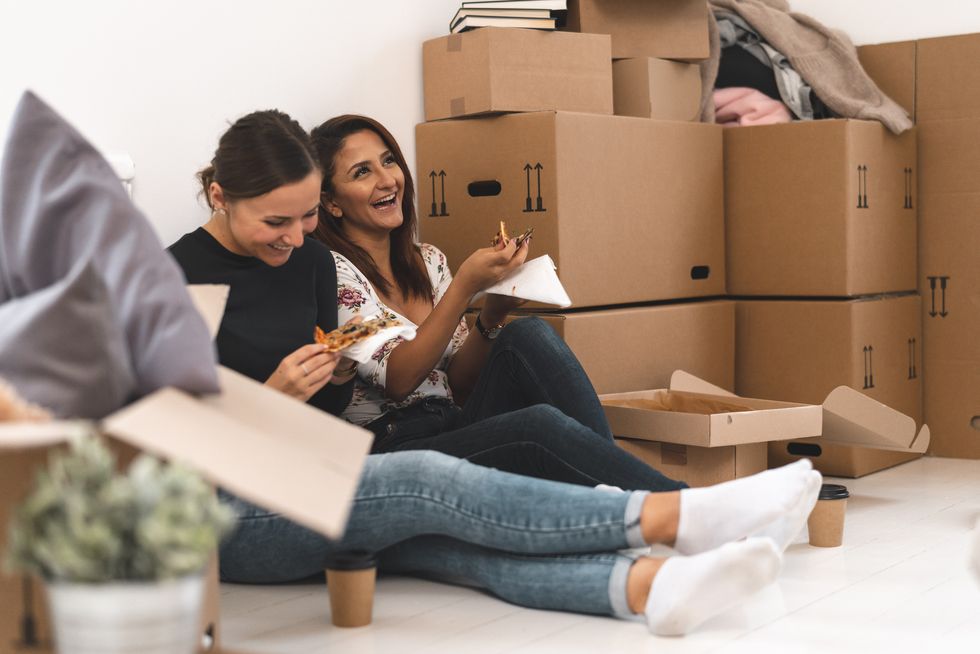Friendships are love stories too. In the Shondaland series The Art of Friendship, we explore and appreciate the beauty and complexities of friendship, as well as what makes it so powerful. From expert tips on how to build friendships and navigate conflicts to uplifting moments of connection, these stories are reminders of the joy, value, and meaning that companionship brings to our lives.
Sara Richard never liked the idea of being in a sorority. That is until she was persuaded by a friend to join a new one on campus during her sophomore year of college. At the inaugural Halloween gathering in 2013, Richard spotted someone standing alone wearing a polka-dot dress, with a flower tucked behind her ear. “I was like, ‘I got to be next to this girl,’” Richard, now a 28-year-old development coordinator, recalls.
Richard, with all the confidence of the Leslie Knope blazer she donned, rushed over to the mystery gal, inadvertently cutting in front of three people in the snack line to get to her. “Are you Billie Holiday?” The girl nodded and replied with a simple “Mm-hmm.” Richard shared how much she appreciated the musical legend and her costume. Her sorority sister timidly thanked her, and after a quick exchange, they went their separate ways.
Two years later, Richard found herself partnered up with the shy mystery girl at an event. While cleaning off paint brushes together, Richard — as theatrical as she was serious — began belting out the chorus of “Greatest Love of All” by Whitney Houston. The young woman turned to Richard and explained how much that song means to her. While the pair had exchanged a few humble hellos since their initial meeting, they hadn’t yet exchanged names. Richard learned hers was Tatyana White-Jenkins.
The inseparable duo spent the rest of their college years seeking out corners of fraternity parties to talk about their favorite television shows, attending formals as each other’s dates, and watching reruns of Murder She Wrote on weekends. When White-Jenkins studied abroad her senior year, Richard would check in on her via phone from a closet at work, time difference be damned. Little did they know at the time, they would become very best friends, and a few years later, roommates.
Richard and White-Jenkins lived together for one year in Arlington, Virginia, then again a year later in Washington, D.C.. “When we told people we were going to move in together, they were like, ‘Oh, no. The friendship isn’t going to last.’ We proved them wrong,” White-Jenkins, now a 27-year-old communications specialist, says.
Despite what some may claim, there are benefits to moving in with a pal. “You’ve got someone who cares about you, who’s going to know if you come home or not, and actually cares if something were to happen to you,” says Suzanne Degges-White, a licensed counselor and professor at Northern Illinois University. “You’ve got somebody to check in with and touch base with in a way that when you’re trying to build a relationship, you don’t have that same ease.”
Cohabitating with someone you love means having a built-in buddy to chat over coffee, share meals, debrief on dates, and connect with during tough times. When Richard’s grandfather was passing, White-Jenkins was right there to help her through her grief. “I was like, ‘Will you just come lay on the floor with me on the living room floor with our legs up?’ And she did,” Richard says. “That was a very meaningful moment to me.”
“Being able to enjoy the fullness of another person’s company for both the best and worst times is exciting,” says female friendship coach and educator Danielle Bayard Jackson. “It just comes down to navigating the details of what that will look like, which sometimes feels counterintuitive to something you believe that’s supposed to be natural.”
As friends, White-Jenkins’ and Richard’s familiarity with each other’s lifestyles and personalities served them well. Because of this understanding, they were able to ease into living together and effectively communicate. “We were good at saying, ‘This is what I need tonight,’” White-Jenkins says.
Degges-White affirms that while we can know and love someone, we may not have knowledge of all their personal habits. “Or if you do,” she says, “you can go home when you’ve had enough.” The counselor adds that difficulty can come from “not realizing that you are going to have to compromise and not recognizing that if you don’t talk about it, a problem’s not going to go away.”
As someone who was shy and introverted, White-Jenkins has grown in communicating about difficult topics. “I learned that people can’t read your mind,” she reflects. “It’s better to put things forward so that the person can actually understand. It’s never made things bad to say, ‘Hey, actually I feel like this.’”
While living together, the best friends chose to view their differences as preferences, not challenges. “If it was my choice, I would be like, ‘Good morning!’ and give everyone a hug every morning, but that’s not everybody,” Richard says. “That’s not a con. It’s just different styles.” And they learned to bend to each other.
“We know certain ways to say things to each other so that things don’t get weird,” White-Jenkins says. “I struggle to do dishes. If I left them in the sink, I would just have to tell her, ‘Look, I know I’m trash right now. I will get them done tomorrow, I promise you. Just today I can’t do them.’” On the flip side, Richard says living with White-Jenkins has taught her not to read too far into situations or overthink feedback. “I know she’s never going to have ill intent.”
Since living together, Richard and White-Jenkins have not only remained best friends but have become closer. Following their moves home during the pandemic, they now live solo down the street from each other, talk on the phone every day, go on walks together, and travel together with their families. “The foundation we built living together [has] made us stronger,” Richard says, “and I know we can do anything.”
We’ve been taught that friendship should feel organic and unforced at all times, but no deep or meaningful relationship is built on this premise. While sitting down and carving out boundaries with your friend might feel insulting or demeaning in the moment, the future of your friendship could hinge on that conversation.
If you’re close, there may be a fear that your relationship will change if it doesn’t go well, and you won’t be able to recover, but that doesn’t have to be the case. Learning how to live well together is necessary for a successful roommate relationship and a lasting friendship outside of the temporary arrangement.
When it comes to something as deeply personal as a living space, it’s crucial to remember and respect that every individual values theirs in their own unique way. Here are a few ways to prepare as you step into this new chapter with your close pal by your side.
Get ahead of it
We’ve been taught that one of the invisible benefits of friendship is that we shouldn’t have to communicate our needs, and that being close to someone is synonymous with “you should already know how I am or what I like,” but similar to romantic relationships, that isn’t the reality. To save yourself and your bestie a world of trouble, try getting ahead of any potential issues by talking about your living preferences or creating rules up front.
“I don’t think there’s such a thing as too much conversation,” Jackson says. “You’ll never be so close that it transcends a need to communicate with one another.” The friendship coach recommends thinking of the future version of yourself and of your friendship. “[If] you want her to be comfortable and happy and able to speak her mind, to help her out, set those expectations right now.”
Before you unload your car and start unpacking boxes, here are a few questions to answer together when deciding to live with each other:
- Who will pay, and how will you split bills?
- When, how many, and how long can people visit?
- What are acceptable volumes at specific times of day?
- Do you prefer to discuss logistics through text, calls, or in person?
- What level of cleanliness is acceptable?
- How important is alone time?
- What items can be shared or borrowed?
- What types of drug and alcohol use are allowed?
It’s important to remember that everyone comes from different upbringings and backgrounds. “You can’t get mad if someone did something, and you never said [anything],” Degges-White says. That’s why it’s important to have these transparent conversations, no matter how obvious one way of living may seem to you.
Be willing to compromise
Jackson says that if you’re the type of person who likes to do what you want, when you want, and how you want, you should “spend some time thinking about if you’re willing to modify those things to live with your friend.”
While a mentally or physically prepared list of boundaries can be an advantage, it’s helpful to remember that your friend is likely compromising on preferences too. If you are accustomed to blasting loud music during your morning shower, but your friend likes to bring her day in with a quiet meditation, you may have to bend a bit. “Accept that everybody’s going to compromise,” Degges-White says, “because that’s like any relationship.”
From there, communicate your non-negotiables and then decide what can be realigned. “There’s different things that annoy different people,” Degges-White says, “and that’s just the way humans are made up. Don’t assume your way is the only way to live.”
Avoid buildup
A good question to ask yourself is: How do I respond to people when I feel frustrated or annoyed? “If you are irritated by the fact that she’s so loud, do you address it, or do you grow resentful and show it in passive-aggressive ways throughout the day to let her know she’s too loud?” Jackson says.
If you don’t reflect on how you respond to and address these emotions, they will show up in your friendship. “We tend to do that thing where your roommate does one little thing you don’t like, but you don’t say anything, so she keeps doing the thing, and before you know it, you’re blowing up at her on a Tuesday night, and she’s like, ‘Where did that come from?’” Jackson says. Once you catch yourself in that spiral, you may respond in a way that’s out of proportion to the offense.
Jackson says that as a roommate and friend, you have a responsibility to communicate that with them. “I think sometimes we’re scared to be seen as being difficult, rejected, or misunderstood. Therefore, we keep our feelings to ourselves.” To protect your friendship, it’s always worth it to say something.
Establish a monthly meetup
“Have regular meetings where you sit down and you talk about how things are going,” Degges-White advises. This can prevent frustration from building up and keeping you from storing annoyances away for too long. “It’s that drip, drip, drip of an annoying habit that really takes a toll.” She calls it the silent tally, which friends should try to avoid collecting.
This meeting doesn’t have to be formal or monthly, but it works best if it occurs routinely and in a neutral place, such as over coffee at a café or in your favorite booth at a local lunch spot. This gives you and your friend the built-in space to talk about anything that has come up for each of you — negative or positive — especially if it’s hard for you to approach others with your feelings.
Communicate wisely
If you do have a preference that you’d like to bring to your roommate, be mindful of the form you choose. “One of the things that dictates how your message is received is the mode that you choose to communicate it,” Jackson explains. “If we’re cool, and you take the communication to something like a Post-it Note, it’s automatically going to feel weird because that’s not our normal mode of communication, and it feels like you upgraded the formality, which I’m going to interpret as you fussing at me.”
The key to making a request of your cohabitant is to avoid telling them what to do and instead convey in a compassionate way that you want to compromise or figure out a solution together. Rather than leaving an awkward sticky note on a dirty pot pressing them to wash it immediately, acknowledge that they may be busy or going through something, and ask if there’s a way the dishes can be done within a certain time frame. Jackson’s go-to motto in such scenarios is: “How can I bend with you?”
While text may be a typical way to chat, it’s worth noting that disharmony is best resolved when face time is involved. “You have to communicate in person for the fun things and for hard things,” Jackson says, “so nothing gets lost in translation.”
Don’t assume
“Sometimes, friendships end not because roommates don’t get along,” Degges-White says, “[but] because they make assumptions.” Thinking your friend is cool with having someone over — or believing she would not agree to it without ever asking and then holding one-sided resentment — could damage your good graces.
While you may be okay with your friend sifting through your drawers or using your Tupperware to store soup, they may not feel the same way. “When it comes to other people’s resources, whether that’s their stuff, space, or time — because resources come in all shapes and sizes — don’t use another person’s resources without checking in first,” Degges-White says. No matter how close you are, it’s always a safer bet to ask before you use your friend’s property or invite company into your shared space.
Avoid character judgments
If your friend does borrow your new dress without asking or take the last of your cereal without checking, extend the benefit of the doubt. “We tend to attribute certain conflicts to character,” Jackson says. “Some of us have a habit of doing that, and that’s very dangerous.”
Assigning a friend as being selfish or thoughtless poses the biggest threat to a lasting friendship outside of the house. If your roomie jumps to conclusions, it doesn’t mean that you have to in return. When your brain automatically goes to character judgments, your friendship will be more difficult to reconcile when you leave the house and this chapter of your relationship ends.
“You’re going to have conflicts and misunderstandings while you figure each other out,” Jackson says. “You’re going to find your rhythm.” In the meantime, if someone does overstep a boundary — whether it was previously discussed or not — try to view it less as a conflict and more as an opportunity to get on the same page with each other and grow together. At the end of the day, friendships are what gets us through life.
Mia Brabham is a staff writer at Shondaland. Follow her on Twitter at @hotmessmia.
Get Shondaland directly in your inbox: SUBSCRIBE TODAY

















